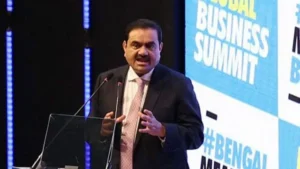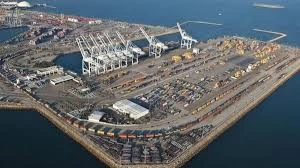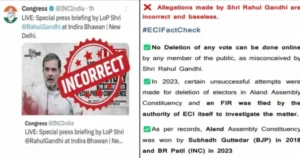September 19th Current Affairs
Table of Contents
Kannada Literature Optional Syllabus
Home / ಐಚ್ಚಿಕ ಕನ್ನಡ ಸಾಹಿತ್ಯದ ಪಠ್ಯಕ್ರಮ ಐಚ್ಚಿಕ ಕನ್ನಡ ಸಾಹಿತ್ಯ ಪತ್ರಿಕೆ – 1 ವಿಭಾಗ – ಎ ಅ) ಕನ್ನಡ ಭಾಷೆಯ ಚರಿತ್ರೆ ಭಾಷೆ
UPSC Current Affairs – October 6th
October 06th Current Affairs Home / Table of Contents 36-hour curfew imposed in parts of Odisha’s Cuttack over communal tensions
Religious Minorities in India and the Challenge of Communal Harmony: A Sociological Reflection on the Cuttack Violence
Home / Religious Minorities in India and the Challenge of Communal Harmony: A Sociological Reflection on the Cuttack Violence Sociology
UPSC Current Affairs – October 4th
October 04th Current Affairs Home / Table of Contents Isabgol Processors threaten to halt purchases from October 6th over GST
Sologamy and Contemporary Trends in Marriage: A Sociological Perspective
Home / Sologamy and Contemporary Trends in Marriage: A Sociological Perspective Sociology Paper 1: Systems of Kinship – Contemporary trends
UPSC Current Affairs – October 3rd
October 03rd Current Affairs Home / Table of Contents NASA IMAP to show how solar particles are energised and shield
Understanding Indian Festivals through Durkheim: Religion, Rituals, and Collective Conscience
Home / Understanding Indian Festivals through Durkheim: Religion, Rituals, and Collective Conscience Sociology Paper 1: Émile Durkheim – Religion and
UPSC Current Affairs – September 30th
September 30th Current Affairs Home / Table of Contents Ladakh groups reject talks with government, Ministry says open to dialogue
Caste Census in India: A Sociological Perspective
Home / Caste Census in India: A Sociological Perspective Sociology Paper 2: Caste System – Features of Caste system. The
Constitutional Morality: Upholding India’s Democratic Ethos
Home / Constitutional Morality: Upholding India’s Democratic Ethos Sociology Paper 2: Visions of Social Change in India – Constitution, law,
Clean chit for Adani: Sebi dismisses insider trading and manipulation claims raised by Hindenburg

Relevance to UPSC
GS Paper II – Polity & Governance / Regulatory Mechanisms:
- Regulatory bodies in India (SEBI), their powers, limits, functioning
- Rule of law
- Prospective vs retrospective application of law/regulation
- Legal definitions (related-party transactions, insider trading)
GS Paper III – Economy / Financial Sector:
- Securities market regulation
- Investor protection
- Financial fraud and transparency
- Stock market dynamics
- Impact of regulatory findings on markets and investment climate
GS Paper IV / Ethics:
- Accountability
- Transparency in corporate affairs
- Ethics in business
- Corporate governance
More About the News
- SEBI has cleared Gautam Adani, Rajesh Adani and certain Adani Group firms (Adani Ports & SEZ, Adani Power, Adicorp) of the allegations made by Hindenburg Research involving insider trading, market manipulation, and related-party transaction violations.
- The regulator found that the transactions alleged to be manipulative or fraudulent were genuine business dealings, were interest-bearing, had been repaid fully, and under the rules at that time did not violate SEBI regulations.
- SEBI noted that newer amendments (from 2023) to the related-party / disclosure norms are prospective, meaning those amendments were not in force during the period of investigation, so cannot be applied retroactively.
Securities and Exchange Board of India (SEBI)
SEBI is India’s statutory regulator for the securities market established initially in 1988 and given statutory status by the Securities and Exchange Board of India Act, 1992. It aims to protect investors’ interests, promote the development of the securities market and regulate its functioning through rule-making, supervision and enforcement. SEBI’s evolving rule-book and enforcement actions shape investor confidence, corporate governance and capital formation in the economy.
Evolution
- 1988: SEBI established as an executive body (response to market malpractices, need for an independent regulator).
- 1992: SEBI Act enacted; SEBI became a statutory regulator with powers to make regulations, investigate and adjudicate.
- 1996 onward: Depositories Act (1996) and other laws integrated electronic/clearing reforms; continuous regulatory upgrades to meet international standards (T+2 settlements, dematerialisation).
- 2000s–2020s: Progressive rule making on mutual funds, insider trading, disclosure norms, corporate governance and technology / cyber resilience.
Key Trends
- Gradual strengthening of investor protection (stricter disclosure, grievance redress).
- Emphasis on corporate governance (board norms, independent directors — Kotak Committee influence).
- Shift to digital markets & resilience (clearing, settlement, cyber frameworks).
- Increasing cross-border scrutiny and cooperation (global investigations, investor activism).
- Active use of data, surveillance and deterrent enforcement (probes, penalties, interim measures).
Statutory Provisions
Established under the SEBI Act, 1992, i.e., its powers derive from statute (quasi-legislative, quasi-executive and quasi-judicial).
Roles and Functions
- Protect investors’ interests.
- Regulate securities market participants (issuers, brokers, exchanges, mutual funds, portfolio managers).
- Frame and enforce regulations (listing, disclosure, insider trading, takeovers, delisting).
- Conduct investigations and take enforcement action (penalties, suspensions, directions).
- Promote market development, transparency and investor education.
Works under which Nodal Ministry?
SEBI functions under the Ministry of Finance, Government of India (administrative domain).
Notable works / initiatives
- Dematerialisation & Depositories framework (Depositories Act, 1996): eliminated physical share certificates.
- Short-selling / settlement modernisation (T+2 etc.) and market infrastructure upgrades.
- Investor education and grievance redressal (SCORES portal).
- Strengthening mutual fund regulation and transparency.
- Cybersecurity & cyber resilience framework and surveillance enhancements.
Notable Regulations & Important Amendments
- SEBI Act, 1992: Statutory authority establishing SEBI.
- Listing Obligations & Disclosure Requirements (LODR) Regulations, 2015: Continuous disclosure framework.
- Prohibition of Insider Trading Regulations, 2015: Modern PIT framework.
- Substantial Acquisition of Shares & Takeovers (Takeover Code), 2011: Regulate change of control, mandatory open offers.
- Delisting Regulations, Market Intermediary regulations, Mutual Fund Regulations: Periodic amendments.
Advantages of Having SEBI
- Investor protection: Stricter disclosure norms reduce information asymmetry for retail investors (LODR disclosures).
- Market integrity & fraud deterrence: Prohibition of insider trading and active investigations deter insider misuse.
- Efficient capital formation: Regulated IPO processes and clear listing norms help companies raise capital with investor confidence.
- Standardised corporate governance: Kotak Committee recommendations accepted by SEBI raised board governance standards (board composition, independent directors).
- Technological modernisation & market infrastructure: Dematerialisation and T+2 settlement lowered risk and increased speed of transactions.
Impacts Made by SEBI
- Greater transparency in listed companies: Mandatory continuous disclosures under LODR.
- Reduced settlement risk: Migration to electronic settlements (Depositories Act & rolling settlement cycles).
- Improved governance of financial intermediaries: Registration and conduct norms for brokers and mutual funds.
- Enhanced investor awareness: Investor education campaigns and complaint portals (SCORES).
- Stronger enforcement culture: Penal actions and market suspensions that increase perceived regulator credibility (high-profile probes have market impact).
Challenges Faced
- Complexity of cross-border investigations: Cases involving foreign entities or tax havens create investigative and evidence-sharing hurdles.
- Perception & conflict-of-interest risks: Scrutiny over potential conflicts among regulators/officials can erode trust; recent formation of committees to review conflict rules.
- Keeping pace with fintech / algorithmic trading / crypto: Regulatory gaps and need for rapid policy responses.
- Balancing development vs enforcement: Over-regulation may stifle innovation; under-regulation risks market abuse.
- Resource & capacity constraints: Monitoring a fast-growing, increasingly complex market requires technical and human resources.
Recommendations by Popular Committees
Kotak Committee on Corporate Governance (2017):
- Appointment of at least one independent woman director.
- Stricter norms for related-party transactions, director remuneration, auditor details, and utilisation of funds raised.
- Greater powers to Audit Committee, Nomination & Remuneration Committee (NRC), and Risk Management Committee (RMC) for oversight of funds, governance, and risk management.
Recent internal committee on conflict-of-interest (2025):
- Officials and board members to disclose property, investments, liabilities, etc.
- Introduce a recusal policy: Officials must step away or recuse themselves when there is a real, potential or perceived conflict in matters under consideration.
- Put limitations on investment holdings or asset types that could create conflicts.
- Mechanism for public to report concerns or complaints about conflicts of interest.
- Maintain digital, traceable records for disclosures and compliance so that oversight is easier.
Best Practices from Global Securities Regulators
Regulatory Sandbox for FinTech Innovation – Financial Conduct Authority (FCA), UK: FCA pioneered the idea of a “sandbox” (2016) where FinTech firms can test products under regulatory supervision with limited risks.
Consolidated Audit Trail (CAT) – Securities and Exchange Commission (SEC), USA: SEC mandated creation of a massive audit trail database to track all orders, quotes, and trades across US markets in real time for transparency and fraud detection.
MiFID II Framework – European Securities and Markets Authority (ESMA), EU: Introduced stringent investor protection, transparency norms, and governance standards (2018), reshaping financial market regulation in the EU.
Twin Peaks Model – Australian Securities and Investments Commission (ASIC), Australia: Australia adopted a “twin peaks” model separating prudential regulation (APRA) and conduct/market regulation (ASIC), enhancing accountability.
Way Forward
- Strengthen cross-border cooperation & evidence sharing with foreign regulators.
- Upgrade data & cyber-surveillance capabilities; use AI responsibly for market surveillance.
- Institutionalise stronger conflict-of-interest rules and transparency measures (board and regulator).
- Continuous investor education and digital grievance redress improvements.
- Periodic review of rulebook to balance innovation (fintech, digital assets) and investor protection.
SEBI must keep evolving from a compliance-centric regulator to a data-driven, proactive guardian of market integrity — balancing innovation with investor protection. Strengthening ethical safeguards, international cooperation and technological capacity will be central to preserving investor trust as Indian capital markets scale. A credible, transparent SEBI is pivotal for sustained private investment and financial stability.
Prelims MCQ
Q. Consider the following statements about the Securities and Exchange Board of India (SEBI): 1. SEBI was established by an Act of Parliament in 1988. 2. SEBI is a statutory body with powers that are quasi-legislative, quasi-executive and quasi-judicial. 3. SEBI functions under the administrative control of the Ministry of Finance. Which of the statements given above is/are correct?
A. 1 and 2 only
B. 2 and 3 only
C. 1 and 3 only
D. 1, 2 and 3 only
Mains Question
Q. “Examine the role played by the Securities and Exchange Board of India (SEBI) in strengthening corporate governance and investor protection in Indian capital markets. Discuss the key reforms introduced since 2010, evaluate their effectiveness, and suggest measures to improve SEBI’s capacity to handle cross-border market abuse.
Chabahar operators to face U.S. sanctions from September 29

Relevance to UPSC
GS Paper II – International Relations / Foreign Policy:
- Highlights India-US relations: how US policy (sanctions, bilateral diplomacy) influences India’s strategic projects.
- Iran policy dynamics: implications for India’s balancing act between Washington and Tehran.
- Role of connectivity diplomacy: Chabahar as a key anchor in India’s outreach to Afghanistan and Central Asia.
GS Paper III – Economy / Infrastructure / Trade:
- Implications for trade & logistics: potential disruptions in the trade corridor via Chabahar.
- Investment risk: how foreign regulation/sanctions impact Indian firms engaged in overseas infrastructure.
- Influence on India’s regional connectivity initiatives like INSTC (International North-South Transport Corridor).
More About the News
- The United States has decided to revoke the sanctions waiver previously granted for India’s operations at Chabahar Port under the Iran Freedom and Counter-Proliferation Act (IFCA), effective September 29, 2025.
- This waiver had allowed Indian participation in the port’s operation for trade, connectivity with Afghanistan and Central Asia, bypassing Pakistan. Its expiration threatens operational and investment risks for Indian firms and raises strategic uncertainties.
- The move comes under the US “maximum pressure” policy toward Iran, aiming to isolate Tehran’s regime by revoking exceptions that allowed economic/development activity.
Chabahar Port
The Chabahar Port, located in southeastern Iran along the Gulf of Oman, is Iran’s only oceanic port. India has been involved in its development since 2003, seeing it as a gateway to Afghanistan and Central Asia bypassing Pakistan. Its strategic location makes it a vital element of India’s connectivity, trade, and geopolitical strategy.
Background
- Agreement first signed in 2003 between India and Iran, but progress was slow due to sanctions and geopolitical constraints.
- In 2016, India, Iran, and Afghanistan signed the Trilateral Transit Agreement to operationalize Chabahar.
- India’s India Ports Global Limited (IPGL) operates one terminal, with investments in cranes, equipment, and logistics.
- Chabahar has occasionally received US sanctions waivers due to its developmental role for Afghanistan, but this status remains vulnerable.
Potential and Strategic Importance for India
- Provides direct access to Afghanistan and Central Asia, bypassing Pakistan.
- Serves as a key link in the International North-South Transport Corridor (INSTC).
- Counters China’s presence in the region, especially at Gwadar Port (Pakistan).
- Enhances India’s role in regional connectivity and trade diplomacy.
- Supports India’s energy security by strengthening ties with Iran and Central Asian states.
Advantages of India Operating Chabahar
Bypassing Pakistan for Afghan Trade:
Example: Wheat and medicines sent via Chabahar to Afghanistan despite Pakistan denying land access.Strategic Rivalry with China:
Example: Counters China’s Gwadar Port project under CPEC, giving India a foothold in the same region.Boost to INSTC:
Example: Facilitates shorter trade routes to Russia and Central Asia, reducing freight costs by ~30%.Energy Diplomacy:
Example: Strengthens India-Iran energy ties and provides logistical base for future energy imports.Regional Development Role:
Example: India positioned as a stakeholder in Afghan reconstruction by supplying aid and building infrastructure via Chabahar.
Impacts of Chabahar for India
- Geopolitical Leverage: Improved standing in Central Asia, demonstrated by India’s participation in regional forums via Chabahar.
- Economic Connectivity: Pilot shipments (e.g., fertilizers and pulses) have already showcased reduced costs and transit times.
- Strategic Autonomy: Greater ability to pursue independent regional policy, shown by balancing US and Iranian expectations.
- Improved Relations with Afghanistan: Port enabled continued humanitarian shipments after Taliban takeover.
- Counter to Maritime Encirclement: Provides an alternative strategic access point in the Indian Ocean in counter to China’s “string of pearls.”
Challenges Faced by India
US Sanctions on Iran:
Example: Repeated delays due to waiver cancellations threatening Indian investments.Iran’s Policy Volatility:
Example: Iran sometimes shows impatience with India’s slow progress, exploring Chinese investment options.Security Concerns:
Example: Instability in Iran’s Sistan-Baluchestan region poses operational risks.Financial and Logistical Delays:
Example: Bureaucratic bottlenecks and lack of speedy funding slowed India’s project delivery.Regional Rivalries:
Example: Pakistan and China actively oppose India’s role, especially with Gwadar Port nearby.
Role of India-Iran Ties
- Chabahar is a symbol of India-Iran partnership, even amid tensions over oil imports and sanctions.
- Iran expects quicker progress and balanced engagement, while India uses Chabahar to maintain strategic relevance in Tehran despite US pressures.
Role of USA-India-Iran in the Project
- USA: Oscillates between granting waivers (viewing Chabahar as helping Afghanistan) and imposing sanctions (to isolate Iran).
- India: Navigates carefully to avoid jeopardizing its US ties while retaining Chabahar as a strategic necessity.
- Iran: Leverages the project to attract investment, sometimes hinting at offering more space to China when India delays.
Way Forward
- Secure long-term waiver/diplomatic understanding with the US for uninterrupted operations.
- Accelerate infrastructure investment through IPGL to build credibility with Iran.
- Engage in multilateral frameworks (INSTC, SCO, BRICS) to internationalize Chabahar.
- Enhance security cooperation with Iran to safeguard the port region.
- Maintain balance between strategic autonomy and partnership with the West.
Chabahar embodies India’s pursuit of strategic connectivity, autonomy, and regional leadership. Its future depends on India’s ability to balance great-power rivalries while fast-tracking delivery on the ground. With sustained investment and deft diplomacy, Chabahar can become a cornerstone of India’s Eurasian engagement.
Prelims MCQ
Q. Consider the following statements about the Chabahar Port: 1. It is located on Iran’s Gulf of Oman coast and is Iran’s only oceanic port. 2. India, Iran, and Afghanistan signed a trilateral transit agreement in 2016 to operationalize it. 3. Chabahar provides India direct access to Central Asia bypassing Pakistan. Which of the statements given above is/are correct?
A. 1 and 2 only
B. 1 and 3 only
C. 2 and 3 only
D. 1, 2 and 3
Mains Question
Q. Discuss the strategic and economic significance of Chabahar Port for India. In your answer, evaluate how US sanctions and regional geopolitics have shaped India’s approach to the project, and suggest measures to safeguard its long-term interests.
Hydrogen power plant to be set up on Bengaluru outskirts

Relevance to UPSC
GS Paper III – Environment, Science & Technology, Energy:
- Renewable energy transition: green hydrogen as a clean energy source.
- Technology adoption (electrolysis), resource usage (solar, water), and energy efficiency.
- Role in meeting India’s net-zero targets and tackling climate change.
GS Paper III – Infrastructure & Economic Development:
- Investment in new energy infrastructure, job creation.
- Potential of hydrogen valley model to generate industrial clusters and ancillary industries.
- Economic cost vs benefit, capital required, feasibility.
More About the News
- Alliance University plans a pilot green hydrogen energy plant in Hakki Pikki Colony (near Bannerghatta National Park, Bengaluru outskirts), cost approx ₹25 crore, proposal submitted to the Union & State governments.
- First 18 months will focus on research: Using lake water or rain water to produce hydrogen via electrolysis, with solar power supplying energy, the output oxygen will be sent to health units and ammonia to fertiliser industry.
- If successful, a full-scale “hydrogen valley” will follow, modelled on others in Pune, Kochi, Amaravati. Budget estimated at ₹150-200 crore
Hydrogen Energy
Hydrogen energy is emerging as a transformative solution in the global shift toward clean energy, offering high energy density with zero emissions at point of use. India has recognized its potential under the National Green Hydrogen Mission (2023) to achieve energy independence and net-zero goals. Its versatility across transport, industry, and power generation makes it a critical pillar of future energy systems.
Evolution
- 18th–19th century: Hydrogen identified as a fuel source (early combustion experiments).
- 20th century: Hydrogen applied in space exploration (rocket fuel in NASA programs).
- 1970s oil crisis: Renewed interest in hydrogen as an alternative to fossil fuels.
- 21st century: Hydrogen positioned as a clean energy carrier to meet climate commitments (Paris Agreement, Net Zero targets).
- Recent decade: Green hydrogen gained traction with renewable integration (electrolysis powered by solar/wind).
Features of Hydrogen Energy
- Lightest element, high energy per unit mass.
- Can be produced from multiple sources (renewables, fossil fuels, biomass).
- Versatile: transport, power, industrial feedstock.
- Zero carbon emissions if produced from renewables (green hydrogen).
- Can be stored and transported as gas or liquid.
Advantages of Adopting Hydrogen Energy
Clean Energy Source:
Green hydrogen produces only water vapor as a by-product.Energy Storage Medium:
Can store surplus renewable energy for later use.
Example: Germany’s “Hydrogen Valleys” integrate wind-to-hydrogen projects.Industrial Decarbonization:
Acts as a replacement for coal in the steel sector, helping reduce carbon emissions.Energy Security:
Reduces dependence on imported fossil fuels.
Example: India’s National Green Hydrogen Mission (NGHM) targets 5 MMT annual production by 2030.Transport Applications:
Hydrogen fuel cell vehicles offer long driving range and quick refueling times.
Disadvantages of Adopting Hydrogen Energy
High Production Cost:
Electrolysis is still costlier than fossil fuel-based hydrogen.
Example: India’s green hydrogen costs ~₹350/kg vs. natural gas-based hydrogen ~₹150/kg.Storage and Transport Issues:
Requires high-pressure tanks or cryogenic conditions, making logistics expensive.Infrastructure Deficit:
Limited hydrogen refueling stations and pipelines.
Example: India currently has fewer than 5 hydrogen refueling points.Energy Losses:
Electrolysis and compression cycles have lower efficiency, leading to energy wastage.Dependence on Renewable Power:
Large renewable energy capacity required, which may strain power grids.
Example: India needs >100 GW renewable capacity dedicated to green hydrogen production.
Impacts of Hydrogen Energy
Climate Change Mitigation:
Replacing fossil fuels in heavy industries significantly lowers CO₂ emissions.Job Creation:
Development of new hydrogen ecosystems creates employment.
Example: India’s National Green Hydrogen Mission (NGHM) is expected to generate ~6 lakh jobs by 2030.Geopolitical Shifts:
Hydrogen trade is emerging as a new area of global energy cooperation.
Example: Australia is already exporting green hydrogen to Japan.Boost to Innovation:
Drives R&D in fuel cells, storage systems, and electrolysis technology.
Example: IITs and CSIR labs in India are working on indigenous hydrogen tech.Air Quality Improvement:
Hydrogen buses and vehicles can significantly reduce particulate matter in urban transport.
Challenges in Harnessing Hydrogen
High Capital Costs:
Electrolyzers, storage facilities, and transport infrastructure are still very expensive.Water Requirement:
Electrolysis requires significant freshwater, which may strain water-scarce regions.Policy Uncertainty:
Lack of clear hydrogen pricing mechanisms and trading frameworks creates investor hesitation.
Example: India has yet to finalize a hydrogen trading platform.Global Competition:
Other nations like Australia, Japan, and EU are ahead in hydrogen technology and market readiness.Grid Integration Issues:
Large-scale renewable deployment for hydrogen production may disrupt grid stability and distribution balance.
Government Measures / Initiatives
- National Green Hydrogen Mission (2023) – Target 5 MMT annual production by 2030.
- PLI Scheme for Electrolyzers – Incentives for domestic manufacturing.
- Hydrogen Policy (2022) – Open access to renewable power for hydrogen production.
- R&D Funding – MNRE and DST supporting hydrogen tech projects.
- International Collaboration – India-EU Hydrogen Partnership, India-Japan Fuel Cell collaboration.
Types of Hydrogen: Features & Sources
Type | Source of Energy / Production Method | Features |
Grey Hydrogen | Natural gas reforming / coal gasification | Cheapest, high CO₂ emissions. |
Blue Hydrogen | Fossil fuels + Carbon Capture & Storage (CCS) | Lower emissions, but CCS costly & not 100% effective. |
Green Hydrogen | Electrolysis using renewable power (solar, wind) | Zero emissions, sustainable, but costly. |
Black/Brown Hydrogen | Coal gasification (without CCS) | Highly polluting, high carbon footprint. |
Turquoise Hudrogen | Methane pyrolysis (solid carbon byproduct) | Emerging tech, potentially low emissions. |
Pink/Purple Hydrogen | Electrolysis using nuclear energy | Low-carbon, reliable, dependent on nuclear acceptance. |
Way Forward
- Scale up renewable energy for cost-competitive green hydrogen.
- Establish hydrogen corridors with refueling infrastructure.
- Promote R&D in electrolyzers, storage, and fuel cells.
- Build international partnerships for hydrogen trade.
- Implement regulatory clarity and carbon pricing to incentivize adoption.
Hydrogen energy represents the frontier of India’s clean energy transition, bridging industrial needs with environmental sustainability. With strategic policy, investment, and partnerships, India can emerge as a global hub for green hydrogen. The coming decade will decide if hydrogen becomes the backbone of India’s net-zero future.
Prelims MCQ
Q. Which of the following statements is/are correct about Green Hydrogen?
1. It is produced by electrolysis of water using renewable energy.
2. It releases carbon dioxide during production.
3. India’s National Green Hydrogen Mission targets 5 million tonnes production by 2030.
A. 1 and 3 only
B. 1 only
C. 2 and 3 only
D. 1, 2, and 3
Green hydrogen is produced via electrolysis using renewable power, making it emission-free. India’s NGHM (2023) aims at 5 MMT production by 2030. Statement 2 is incorrect as it produces only oxygen as byproduct, not CO₂
Mains Question
Q. Hydrogen energy is considered the fuel of the future. Critically examine its role in India’s energy transition, highlighting its advantages, challenges, and policy initiatives. Suggest measures to make India a global leader in green hydrogen.
Rahul Gandhi's allegations on vote theft are baseless, incorrect: ECI

Relevance to UPSC
GS Paper II – Polity & Governance / Constitutional Bodies:
- Role, powers, and accountability of the Election Commission of India in ensuring free & fair elections.
- Legal/procedural safeguards in electoral law (voter registration, deletion, hearing, FIRs) and public trust in constitutional institutions.
- Impact of allegations and fact checks on legitimacy and credibility of election regulatory bodies.
GS Paper IV – Ethics / Transparency / Public Administration:
- Issues of transparency in electoral roll management and dispute resolution.
- Moral responsibility of public officials and institutions to uphold democratic integrity.
- Handling of dissent, public allegations, and ensuring due process.
More about the News
- Rahul Gandhi alleged that in Aland (Karnataka), over 6,000 votes were deleted (especially from Congress-leaning booths, Dalits, minorities), and similar alleged irregularities in Rajura (Maharashtra).
- The Election Commission of India (ECI) responded quickly, calling the allegations “incorrect and baseless”, noting that an FIR had been filed already in 2023 in Aland over unsuccessful deletion attempts, and that most of the Form 7 deletion applications were found invalid and rejected.
- Rahul Gandhi further insisted that the Chief Election Commissioner blocked the Karnataka CID’s attempts to get details (like OTP trails, IPs, device ports) necessary for investigation. ECI says no public deletion of votes is possible online without due process.
Election Commission of India (ECI)
The Election Commission of India (ECI) is the constitutional body entrusted with conducting free and fair elections to Parliament, State Legislatures, the offices of President and Vice-President, and supervision of the electoral machinery. Over decades it has evolved from a small administrative office into a powerful, technology-driven electoral regulator tasked with preserving democratic legitimacy. Its impartial functioning is central to the health of Indian democracy.
Evolution
- 1950 — ECI created under Article 324 of the Constitution (initially a single CEC).
- 1960s–1970s — Expanded administrative capacity as Indian elections grew in scale.
- 1990s–2000s — Reforms: introduction of Electronic Voting Machines (EVMs), Voter ID cards, statutory measures to strengthen process integrity.
- 2010s–2020s — Greater use of technology (EVM-VVPAT pairing, digital roll management), Model Code of Conduct institutionalisation, voter awareness drives.
Constitutional & Non-Constitutional Provisions
- Constitutional Provisions: Article 324 — vests the power of superintendence, direction and control of elections in the ECI; establishes it as a constitutional body.
- Non-constitutional Provisions: Detailed operational rules, conditions of service, and many procedural aspects derive from statutes (e.g., Representation of the People Act, 1951), rules, and executive orders. Recent bills seek to codify appointment/terms further.
Roles & Functions
- Conduct free and fair elections to Parliament and State Legislatures, and supervise electoral administration.
- Prepare and revise electoral rolls, including deletions, additions and SIR (Special Intensive Revision) operations.
- Enforce the Model Code of Conduct (MCC) during elections.
- Regulate political party recognition, symbols and candidate nominations; monitor election expenditure.
- Implement technology solutions (EVMs, VVPAT) and grievance redressal; undertake voter education.
Notable Works / Initiatives
- Introduction and nationwide roll-out of EVMs + VVPATs to improve transparency and speed.
- Model Code of Conduct (MCC) — binding electoral ethics and conduct for parties & candidates.
- Systemic reforms & voter services — National Voters’ Day, electoral literacy, voter facilitation portals and grievance systems.
- Recent set of process reforms / 23–28 new initiatives announced to strengthen electoral processes and logistics (ECI press outputs).
Recent Amendments
- Legislative attempts to codify appointment/term/conditions: Aiming to clarify qualifications, method of appointment and tenure. These have generated debate on institutional independence.
- Administrative reforms & new initiatives (2024–25): a package of process reforms, digital enhancements and capacity-building measures announced by ECI to improve electoral logistics.
Appointment, Tenure & Removal
- Appointment: Chief Election Commissioner (CEC) and Election Commissioners (ECs) are appointed by the President of India (convention: on the recommendation of the Union government); the exact consultative procedure is not laid down in the Constitution.
- Tenure/Removal: CEC/ECs enjoy protections similar to Supreme Court judges regarding removal—removal of CEC requires impeachment (two-thirds) for proven misbehaviour or incapacity; removal of other ECs is subject to rules that aim to preserve independence. Recent bills propose clearer service conditions.
Relation with the Representation of the People Act, 1951 & Model Code of Conduct
- RPA, 1951: Principal statutory framework for conduct of elections (qualification/disqualification of MPs/MLAs, corrupt practices, return of election, by-elections). ECI enforces provisions of the RPA through electoral administration and prosecution referral.
- Model Code of Conduct (MCC): A non-statutory but binding set of norms enforced by ECI during elections to ensure ethical conduct by parties and candidates. MCC is enforced administratively (censure, warnings, show-cause notices) and is central to daily ECI functioning.
Recent Issue: Special Intensive Revision (SIR)
SIR controversy (Bihar and other states) — ECI’s Special Intensive Revision of rolls led to mass deletions/queries, civil society and some parties challenged transparency and legality, Supreme Court involvement followed to adjudicate fairness and to direct ECI on disclosure/claims procedures. This raised issues of procedure, transparency and the judicial review of ECI actions.
Benefits of having ECI
Independent Electoral Arbiter:
Secures free and fair elections.
Example: Peaceful conduct of large-scale national elections since 1952.Standardised Electoral Procedures:
Nationwide rollout of EVMs and VVPATs standardises voting, reducing fraud risk.Electoral Integrity via MCC:
Model Code of Conduct curbs misuse of official machinery during campaigns.Voter Empowerment & Inclusion:
Initiatives like National Voters’ Day, simplified registration, and grievance redressal portals boost participation.Dispute Prevention & Confidence:
Acts as a neutral administrator, reducing post-poll disputes and ensuring legitimacy of government formation.
Impacts made by ECI
- Mass-scale electoral management: Efficient conduct of multi-phase general elections across diverse geographies.
- Technological modernisation: EVMs & VVPATs have sped voting and counting and enhanced verifiability.
- Promoting voter awareness: Electoral literacy and targeted drives have improved enrolment (National Voters’ Day).
- Electoral discipline: MCC enforcement curbs blatant misuse of state resources during campaigns.
- Judicial-administrative interface: ECI’s decisions are regularly tested in courts. Example: Recently Supreme Court heard the Bihar’s SIR Issue and delivered it’s Orders.
Challenges & Criticism
Perception of Political Influence in Appointments:
Criticism that the appointment procedure lacks transparency, raising questions about ECI’s independence.
Example: Ongoing debates around bills to codify appointment process.Transparency in Roll Revision (SIR):
Allegations of arbitrary deletions in electoral rolls have led to litigation and public criticism.Enforcement Limits of MCC:
Model Code of Conduct (MCC) is not statutory, so punishments are largely administrative (e.g., censure) rather than legal.
Critics demand stronger statutory backing.Technological Distrust & Misinformation:
Persistent scepticism around EVMs and VVPATs despite judicial validation; continuous public confidence-building is required.Operational Challenges in Large/Fragile Settings:
Ensuring free and fair voting in conflict zones, remote areas, or during pandemics demands significant logistical effort and risk management.
Best practices
- Automatic & Continuous Voter Registration Elections, Canada: Continuous voter list maintenance & data matching to keep rolls updated.
- Independent Appointment Panels / Transparent Selection, Electoral Commission for Northern Ireland / UK: Transparent selection processes to strengthen institutional independence).
- Electoral Technology Testing Labs Electoral Commission, UK: Independent testing and certification of voting technology before deployment.
- Voter Education & Inclusive Outreach Programmes, Australian Electoral Commission (AEC): Targeted outreach for indigenous and remote voters.
Way Forward
- Codify transparent appointment/tenure norms while preserving constitutional independence (legislative clarity with safeguards).
- Enhance transparency in roll revisions: publish clear criteria, maintain audit trails and easy redressal for deletions (learn from judicial directions in SIR cases).
- Statutory backing for stronger MCC enforcement or clearer legal remedies for MCC violations.
- Strengthen technology audit & public communication to build trust in EVM/VVPAT and other digital tools.
- Capacity building & international best-practice adoption for roll maintenance, cyber-security, and logistics management.
As Indian democracy grows in scale and complexity, the ECI must combine constitutional independence with modern administrative transparency. Institutional reforms that strengthen appointments, technological audits and roll-management transparency will be central to preserving electoral legitimacy. A resilient, well-resourced ECI will remain the bedrock of popular sovereignty in India.
Prelims MCQ
Q. Consider the following statements about the Election Commission of India (ECI):
1. The ECI is established by a statute enacted by Parliament.
2. Article 324 of the Constitution vests superintendence, direction and control of elections in the ECI.
3. The Model Code of Conduct (MCC) is a statutory code with penalties laid down in the Representation of the People Act, 1951.
Which of the statements given above is/are correct?
A. 1 only
B. 2 only
C. 2 and 3 only
D. 1, 2 and 3
Statement 2 is correct — Article 324 establishes the constitutional basis for ECI’s powers. Statement 1 is incorrect — ECI is a constitutional body, not created by a statute (though statutes like RPA-1951 flesh out electoral law). Statement 3 is incorrect — MCC is an administrative (non-statutory) code enforced by ECI, not a statutory code under RPA-1951. .
Mains Question
Q. Examine the role of the Election Commission of India in preserving democratic processes. Discuss the major institutional challenges it faces (with reference to recent controversies such as roll revisions/SIR) and suggest measures to improve its transparency and independence.
Govt to push geothermal pilots under new policy; Iceland, Norway firms eye sites in Uttarakhand, Arunachal

Relevance to UPSC
GS Paper III – Energy, Environment, Science & Technology:
- Renewable energy diversification: geothermal as under-utilized clean energy source.
- Technology adoption (enhanced geothermal systems, R&D, geoscience surveys).
- Environmental impacts and sustainability in exploitable sites (hot spring ecology, Himalayan fragile zones).
GS Paper III – Infrastructure & Economic Development:
- Potential to electrify remote / hilly / off-grid regions (Uttarakhand, Arunachal) with local clean power.
- Cost-benefit in terms of reduced power cost per unit in remote areas (e.g., islands or Himalayan regions).
- Industrial & economic opportunities from pilot projects & private & foreign investments.
More about the News
- The Government of India has released a new National Policy on Geothermal Energy, under which research firms from Iceland and Norway are interested in running pilot / R&D projects in sites such as Uttarakhand, Arunachal Pradesh, and the Gulf of Cambay.
- India has identified about 381 hot springs across the country (surface temps between ~35°C to ~89°C) and estimates its geothermal potential at ~10.6 GW, which could rise with further exploration.
- Key challenges include high upfront cost (approx ₹36 crore per MW), exploration risks, and the need for inter-ministerial coordination; government is exploring financial support (like viability gap funding) and technological collaborations.
Geothermal Energy
Geothermal energy is thermal energy stored in the earth’s crust that can be harnessed for power generation and direct-use heat applications. It offers a baseload, low-carbon source of energy with applications from electricity generation to heating, cooling and industrial process heat. Scaling geothermal in India can diversify the renewables mix, support decarbonisation of industry, and provide reliable power to remote and hilly regions.
Key Trends
- Growth of binary cycle and small modular geothermal plants suitable for low-temperature resources.
- Rising interest in EGS to tap resource-poor regions by creating artificial reservoirs.
- Integration with industrial decarbonisation (steel, chemicals) and green hydrogen production.
- Use of geothermal for district heating/cooling and agricultural drying.
- International technology cooperation & financing for exploration risk mitigation.
Sources of Geothermal Energy
- Natural hydrothermal reservoirs (hot water / steam) — high enthalpy for power.
- Hot dry rocks / EGS — fractured deep rocks heated but lacking fluid.
- Geopressured systems — hot fluids with dissolved methane.
- Shallow ground heat — ground-source heat pumps for heating & cooling.
- Hot springs — direct-use applications (spa, balneology, bathing).
Features of Geothermal Energy
- Baseload capability — continuous 24×7 operation independent of weather.
- Low operational emissions — near-zero CO₂ at point of use for green/geothermal heat.
- Site-specific resource — geology determines feasibility and yield.
- High upfront cost / exploration risk — major expense in drilling and resource characterisation.
- Multiple applications — electricity, process heat, district heating, desalination, agriculture.
Advantages of Adopting Geothermal Energy
Reliable Baseload Power:
Geothermal plants supply constant, uninterrupted power.
Example: Iceland’s national grid relies heavily on geothermal energy.Low Lifecycle GHG Emissions:
Replacing coal in district heating reduces carbon footprint and local air pollution.Local Energy for Remote/Hilly Areas:
Ideal for powering regions where grid extension is expensive or difficult.Industrial Process Heat Supply:
High-temperature geothermal sources can meet energy needs of steel and chemical industries, reducing fossil fuel dependency.Small Footprint & Long Plant Life:
Geothermal plants occupy less land than solar farms and can run for decades with proper reservoir management.
Disadvantages of Adopting Geothermal Energy
- High exploration & drilling costs: Deep drilling failures incur big sunk costs.
- Resource risk & uncertainty: A site may not yield an expected temperature/ flow.
- Induced seismicity risk: EGS and fluid injection have caused minor earthquakes.
- Site limitation: Not all regions have exploitable high-temperature reservoirs.
- Water usage & contamination risk: Geothermal fluids can be saline or contain toxic minerals requiring treatment.
Impacts of Geothermal Energy
- Decarbonisation of electricity & heat: Replaces coal/gas for baseload and heating.
- Energy security & reduced imports: Domestic geothermal reduces fossil fuel import dependence in resource-rich countries.
- Rural & regional development; Local jobs in plant construction and maintenance for remote areas.
- Enables industrial competitiveness: Cheap, predictable process heat can lower costs for local industries.
- Synergy with other clean tech: Pairing geothermal with electrolysers for continuous hydrogen production increases renewables utility.
Challenges in Harnessing Geothermal
- Financing & investment risk: Private investors hesitant due to up-front exploration risk..
- Technical capacity & R&D gap: Limited national expertise in EGS and deep drilling.
- Environmental & social consent: Local opposition over land use, water or seismicity concerns can delay projects.
- Regulatory & institutional barriers: Unclear licensing, spectrum of mineral/subsurface ownership, cross-sector coordination.
- Infrastructure & grid integration: Remote sites need transmission links; grid upgrades may be required to utilise new baseload supply.
National Policy on Geothermal Energy
- Resource mapping & exploration support: Funding and technical assistance for surveys and exploratory wells.
- Risk mitigation instruments: Exploration risk insurance or public co-funding of first wells.
- Tariff & offtake mechanisms: Feed-in tariffs or power purchase agreements suited to baseload geothermal.
- Environmental & social safeguards: Standards for water use, waste disposal, seismic monitoring, community engagement.
- Incentivise direct-use markets: Grants/loans for district heating, industrial heat adoption and pilot clusters.
Best Practices
- Puga (Ladakh) exploratory work (GSI/ONGC/NTPC): government-sponsored exploration and pilot testing in a high-temperature site to build technical knowledge.
- Tattapani pilot (Chhattisgarh): demonstration of small-scale geothermal plant and direct heat use showcasing regional applications.
- Hellisheiði Geothermal Power Station (Iceland): integrated electricity and district heating providing large-scale low-carbon energy and industrial heat.
- The Geysers (California, USA): largest single geothermal field for electricity, demonstrating long-term reservoir management and maintenance practices.
Way Forward
- Scale up resource mapping and publicly fund first-of-a-kind exploratory wells to reduce private risk.
- Adopt exploration risk insurance / viability gap funding to attract private capital.
- Invest in local capacity building (drilling tech, reservoir engineering) and R&D in EGS.
- Create clear regulatory regime for subsurface rights, environmental safeguards and seismic monitoring.
- Promote direct-use applications (heating, desalination, agriculture) as early, low-risk market entry points.
Types of geothermal Energy, their Features & Energy Source
Type / Class | Source / Production Method | Key features |
Hydrothermal (High-enthalpy) | Natural steam or hot water reservoirs tapped by wells | Suitable for electricity generation (flash or dry-steam plants); high temperatures (>180°C). |
Hydrothermal (Low-enthalpy / Binary cycle) | Hot water at moderate temps (~70–180°C) using binary cycle turbines | Enables power generation from lower temps; smaller modular plants; good for many identified sites. |
Enhanced Geothermal Systems (EGS) | Artificially create/expand fracture networks and inject fluids into hot dry rock | Expands resource base beyond natural reservoirs; involves hydraulic stimulation; higher seismic monitoring needs. |
Geopressured / Co-produced resources | Hot brines under pressure, sometimes with methane | Can co-produce heat and hydrocarbons; resource-specific economics. |
Ground Source Heat Pumps (GSHP) / Shallow geothermal | Shallow ground heat exchange for heating/cooling (no electricity generation) | Low temp, widely deployable for buildings/district cooling & heating; high efficiency for space conditioning. |
Volcanic/Flash steam | Direct steam from volcanic vents or high temp fields | High power density but geographically limited to volcanic zones. |
Prelims MCQ
Q. With reference to geothermal energy, which of the following statements is/are correct?
1. Geothermal power plants can provide baseload electricity.
2. Enhanced Geothermal Systems (EGS) reduce exploration risk by eliminating the need for drilling.
3. Binary cycle plants allow electricity generation from moderate-temperature resources.
A. 1 only
B. 2 and 3 only
C. 1 and 3 only
D. 1, 2 and 3
(1) Correct: Geothermal plants can run 24×7 as baseload sources. (2) Incorrect: EGS does not eliminate drilling; it typically requires deep wells and hydraulic stimulation and may increase technical complexity. (3) Correct: Binary cycle technology enables power generation from moderate-temperature fluids by using a secondary working fluid.
Mains Question
Q. Critically examine the potential of geothermal energy in India’s energy mix. In your answer, discuss technical and institutional challenges, exemplary policy measures to de-risk exploration, and concrete steps to scale geothermal for both electricity and industrial heat.




